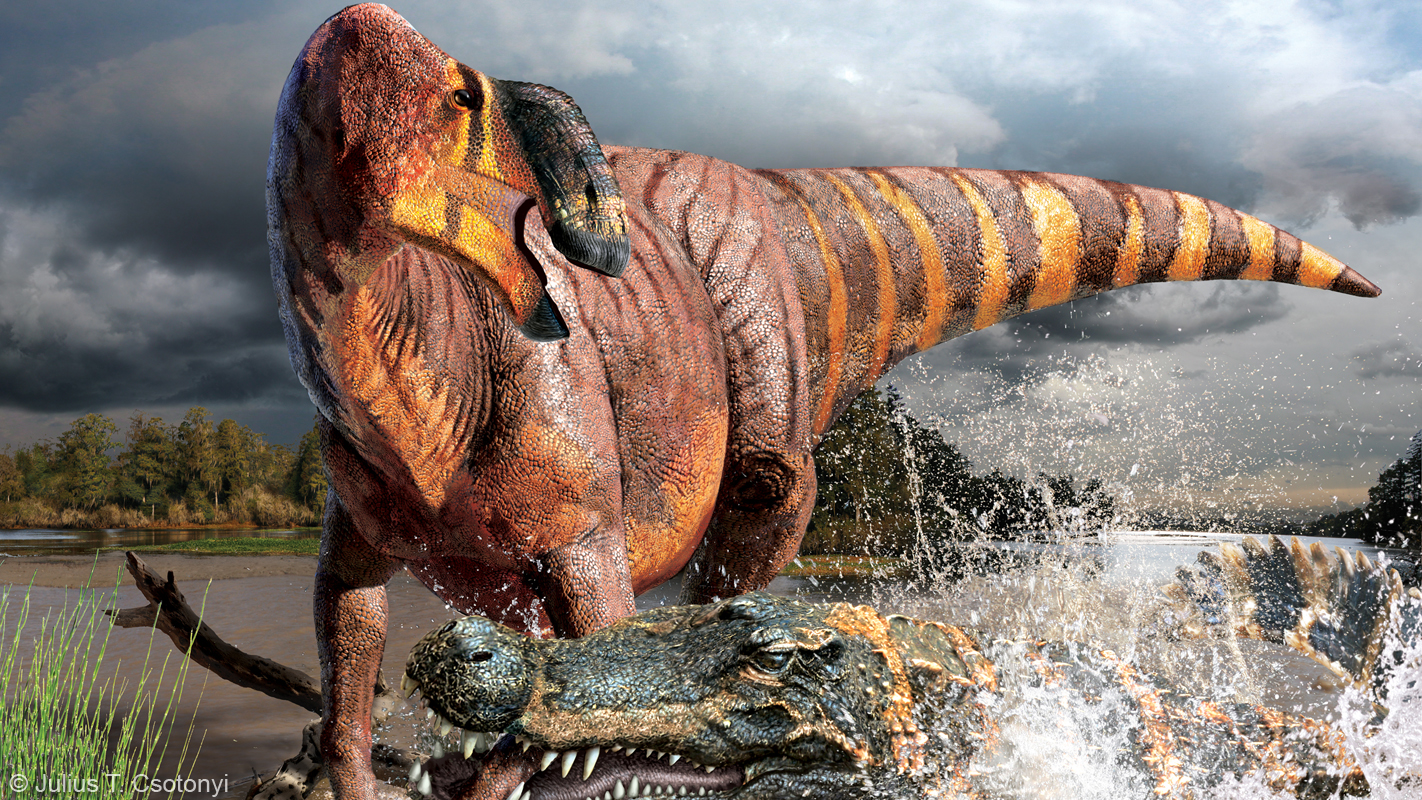For Immediate Release
Call it the Jimmy Durante of dinosaurs – a newly discovered hadrosaur with a truly distinctive nasal profile. The new dinosaur, named Rhinorex condrupus by paleontologists from North Carolina State University and Brigham Young University, lived in what is now Utah approximately 75 million years ago during the Late Cretaceous period.
Rhinorex, which translates roughly into “King Nose,” was a plant-eater and a close relative of other Cretaceous hadrosaurs like Parasaurolophus and Edmontosaurus. Hadrosaurs are usually identified by bony crests that extended from the skull, although Edmontosaurus doesn’t have such a hard crest (paleontologists have discovered that it had a fleshy crest). Rhinorex also lacks a crest on the top of its head; instead, this new dinosaur has a huge nose.
Terry Gates, a joint postdoctoral researcher with NC State and the North Carolina Museum of Natural Sciences, and colleague Rodney Scheetz from the Brigham Young Museum of Paleontology, came across the fossil in storage at BYU. First excavated in the 1990s from Utah’s Neslen formation, Rhinorex had been studied primarily for its well-preserved skin impressions. When Gates and Scheetz reconstructed the skull, they realized that they had a new species.
“We had almost the entire skull, which was wonderful,” Gates says, “but the preparation was very difficult. It took two years to dig the fossil out of the sandstone it was embedded in – it was like digging a dinosaur skull out of a concrete driveway.”
Based on the recovered bones, Gates estimates that Rhinorex was about 30 feet long and weighed over 8,500 lbs. It lived in a swampy estuarial environment, about 50 miles from the coast. Rhinorex is the only complete hadrosaur fossil from the Neslen site, and it helps fill in some gaps about habitat segregation during the Late Cretaceous.
“We’ve found other hadrosaurs from the same time period but located about 200 miles farther south that are adapted to a different environment,” Gates says. “This discovery gives us a geographic snapshot of the Cretaceous, and helps us place contemporary species in their correct time and place. Rhinorex also helps us further fill in the hadrosaur family tree.”
When asked how Rhinorex may have benefitted from a large nose Gates said, “The purpose of such a big nose is still a mystery. If this dinosaur is anything like its relatives then it likely did not have a super sense of smell; but maybe the nose was used as a means of attracting mates, recognizing members of its species, or even as a large attachment for a plant-smashing beak. We are already sniffing out answers to these questions.”
The researchers’ results appear in the Journal of Systematic Palaeontology.
-peake-
Note to editors: The abstract of the paper follows. Images are available; contact NC State News Services. Artist credit: Julius Csotonyi
“A new species of saurolophine hadrosaurid (Dinosauria: Ornithopoda) from the Campanian of Utah, North America”
Authors: Terry Gates, North Carolina State University and the NC Museum of Natural Sciences; Rodney Scheetz, Brigham Young University
Published: Online in the Journal of Systematic Palaeontology
DOI:10.1080/14772019.2014.950614
Abstract: A new species of hadrosaurid is described from the Upper Cretaceous Neslen Formation of
central Utah. Rhinorex condrupus is diagnosed on the basis of two unique traits, a hook-shaped
projection of the nasal anteroventral process and dorsal projection of the posteroventral process
of the premaxilla, and further differentiated from other hadrosaurid species on the morphology of
the nasal (large nasal boss on posterodrosal corner of circumnarial fossa, small protuberences on
anterior process, absence of nasal arch), jugal (vertical postorbital process), postorbital (high
degree of flexion present on posterior process), and squamosal (inclined anterolateral processes).
This new taxon was discovered in estuarine sediments dating to approximately 75 Ma and just
250 km north of the prolific dinosaur bearing strata of the Kaiparowits Formation,possibly
overlapping in time with Gryposaurus monumentensis. Phylogenetic parsimony and Bayesian
analyses associate this new taxon with the Gryposaurus clade, even though the type specimen
does not possess the diagnostic nasal hump of the latter genus. Comparison with phylogenetic
analyses from other studies show that currently consensus exists between general structure of the
hadrosaurid evolutionary tree, but at closer examination there is little agreement among species
relationships.
- Categories:



